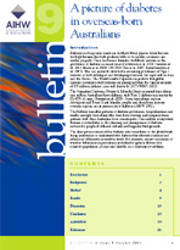Summary
Diabetes is a long-term condition in which blood glucose levels become too high because the body produces little or no insulin, or cannot use insulin properly. There has been a dramatic worldwide increase in the prevalence of diabetes in recent years (Drivsholm et al. 2001; Dunstan et al. 2002; Harris et al. 1998; IDF 2000; Pan et al. 1997; Ramachandran et al. 1997). This rise primarily reflects the increasing prevalence of Type 2 diabetes in both developed and developing countries, but especially in Asia and the Pacific. The World Health Organization predicts that global diabetes prevalence will continue increasing and that the current estimate of 150 million diabetes cases will double by 2025 (WHO 2002).
The Australian Diabetes, Obesity & Lifestyle Study estimated that almost one million Australians have diabetes, with Type 2 diabetes accounting for 85–90% of cases (Dunstan et al. 2001). Some Australians, such as Aboriginal and Torres Strait Islander peoples and those born in some overseas regions, are at greater risk of diabetes (AIHW 2002).
This bulletin describes patterns of diabetes prevalence, hospitalisations and deaths amongst Australians who were born overseas and compares these patterns with their Australian-born counterparts. This analysis is important because it contributes to the planning and management of diabetes services for people of different cultural and linguistic backgrounds.
The descriptive content of this bulletin also contributes to the global work being undertaken to understand why diabetes has affected countries and ethnicities differently around the world. For example, experts are unsure of whether differences in prevalence are linked to genetic factors of a country’s population, its diet and lifestyle, or a combination of these.
- Introduction (635K PDF)
- 040402 Update (635K PDF)
- Background
- Method
- Results (970K PDF)
- 040402 Update (916K PDF)
- Discussion (455K PDF)
- 040402 Update (445K PDF)
- Conclusion
- Appendixes
- References



